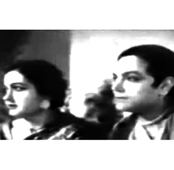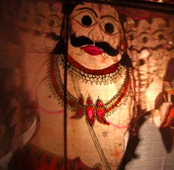-
 Original artwork for TBIP by poster and portrait artist Ramakant Fadte
Original artwork for TBIP by poster and portrait artist Ramakant Fadte
Meena Kumari and all that was lost with her.
The Vinod Mehta memoir Lucknow Boy has this anecdote about Meena Kumari saying “raat gayi baat gayi” to someone she fucked but failed to recognize the next day despite the poor man’s pleas. That rumour, right there, is the reason why good little Bunt girls like Aishwarya Rai wouldn’t even have fantasized about a career as an actress till the seventies, and it would have saved us much of our present nostalgia for ‘good actresses’ if she’d been born a couple of decades earlier. So what a majority of the 50 plus and some Doordarshan-era children in their 30s, like me, are really nostalgic about is not some golden era of magnificent heroines. It is simply about a time when young girls were being austerely trained in well codified arts of bodily enchantment to seek good patronage on the one hand and, on the other, the visual language of representing such feminine beauty in cinema was being borrowed as much from the very same aristocratic tawaif cultures.
To be an actress in these early decades of Hindi cinema, it helped if your mother was a well-established jaan or bai
While film studies scholarship has largely concerned itself with nationalist narratives of cinema cultures it has only rarely traced older performance cultures within it. The lesser recorded spectatorship practice in relation to actresses like Meena Kumari or Nargis is the slowly established democratization of feudal classical performance cultures. The modern cinema was a place where any person who could buy a ticket was able to watch performances of women artists who traced a lineage to high-class tawaifs— a privilege previously reserved for aristocrats. Through these performances, films afforded the newly minted ‘ordinary citizen’ a glimpse of the life that their antecedents would possibly only have had access to as gossip.
And all this within the socially sanctioned modern space of the cinema theatre; even if it was a hard won sanction carved from self censorship (by an industry that, among other things, substituted two roses for an on-screen kiss by the 1950s). This effectively made the theatres a schizophrenic place, one tracing and making space for an older erotic economy and another that was attempting to censor it through reformism. A space where your identification was caught in between Nargis’ Mother India and Meena Kumari’s threatening erotic desires in Pakeezah. Or, if you will, between Bidda Bagchi and Silk.
Born in the late seventies, my familiarity with actresses like Meena Kumari was through the VHS tapes of the nineties and the black and white Archies posters and its hawked copies. But a growing-up-gay narrative that I acquired in my late teens had me recast a distant memory of watching Meena Kumari in Pakeezah; a memory retroactively built to fashion a homosexual persona. The bare bones of it involves my parents nearly leaving for the film without me, then, hearing my wails from the end of the street, returning to sandwich me on our Vespa and taking me to watch the film. The punch line: “They ought to have known right then!”
Reading Hoshang Merchant a few years later in his introduction to Yaarana, an anthology of gay writing from South Asia, made me recognize that this identification with the troubled in-exile figure of Meena Kumari was a narrative trope of homosexual life in the sub-continent. I was that homosexual who “loves women martyred like themselves, their mothers, or Meena Kumari…”
Why not a recent diva? Why not Bhansali’s Madhuri as Chandramukhi or Priyanka Chopra in Fashion? But the thing is that even these two figures are modeled on the real or cinematic life of Meena Kumari. Madhuri is wafting fragrant dhoop into her hair when we first see her in Devdas; a scene lifted right out of Pakeezah. So I wonder if this is not just an anachronism on my part but simply a trace of the tawaif that determines to this day a certain aesthetic performance and appreciation of tragic feminine love.
Merchant tells us that it’s no accident that icons like her “have gay image-makers,” and that “they are literally an invention of the homosexual man, viz., the dress designer, hair stylist, choreographer, the make-up man… ” or even the director. While Merchant might be overstating the case, the point is that the performance and appreciation of femininity in Indian film is hardly wrought through a Stanislavian meditation of some internal female psyche by a woman actor. It seems to have more to do with a quiet quiver of the lips or a heavily lifted eye; and this seems hardcoded into the ways we learn about feminine beauty. So much so that even after years of post-liberalized wooden models colonizing our visual landscape, Sridevi’s classical abhinaya
The queer spectator’s identification with Meena Kumari was contracted on a plane where her on screen characters seamlessly merged with her real life which was suitably more dramatic than her languid screen tragedies. This pact is sealed perfectly in her most memorable role as Chhoti Bahu in Guru Dutt’s Sahib, Bibi Aur Ghulam (1962) where she played a feudal wife who bears the grind of a narrative axe that symbolizes a dying feudal system, preferring the company of a young man and turning to alcoholism in the face of a ruinous marriage to her zamindar husband who prefers the company of a kothewaali. Because what endeared her as Chhoti Bahu had as much to do with the well publicized parallels to her own estranged marriage to filmmaker Kamal Amrohi and her seeking of solace in expensive whiskey, a young Dharmendra, and penning self-deprecatory shayari. And as she lifts her eyes into the first notes of Naa Jaao Saiyaan, we know she is preparing us for the hopelessness of love by making that hopelessness the most desirable state of union. We’re there intensely watching her, identifying with every single gesture, there is no world outside of you and you as her on screen; lonely, tragic, yet so enthralling and so so perfect.
This desire for the melancholia of the one exiled from love is the masochistic flint in the eye of post-liberalization cultural representations; of lovers happily consuming product placements while rushing towards parochial marital unions.
The tawaif, or dancewaali as she is known today, be it Chand in Ishaqzaade or Silk in The Dirty Picture, and their desire to be desired, causes enough anxiety in the narratives of these films, so much that their real-life personas try hard to cover up the act. While the maamis and mamas whistled at Silk all twatted-up to pick her award in the filmic narrative of The Dirty Picture, they wouldn’t be so kind if good girl Vidya Balan were to wear anything but her Kancheevarams to pick up the real ones. Because if she didn’t, then we wouldn’t have good girls in cinema anymore and god forbid poor sluts get a bit of the meaty pie that is the Hindi film industry today!
But in the face of the real life tragedies shifting to the bodies of dance bar girls and other similar women represented in the new wave of non-fiction writing, my desire for the melancholic will make me return to Meena Kumari. Her voice, sharpened to cut, calls to us, leading us into an enchanted world of languid pleasurable pain and, despite the second wave feminist film scholar in me protesting loudly, I am guilty of wanting my bad girls to die on screen—ghungroos slicing into soft skin, stain upon stain of scarlet blood, a face draining into pallid death—and for me to die with them, once more, forever.
Inhi Logon Ne
SpecialsMarch 2013
 By Nithin Manayath
By Nithin Manayath
Nithin Manayath teaches critical theory at Mount Carmel College, Bangalore. A film festival is the only thing that gets him to overcome his travel anxieties.














